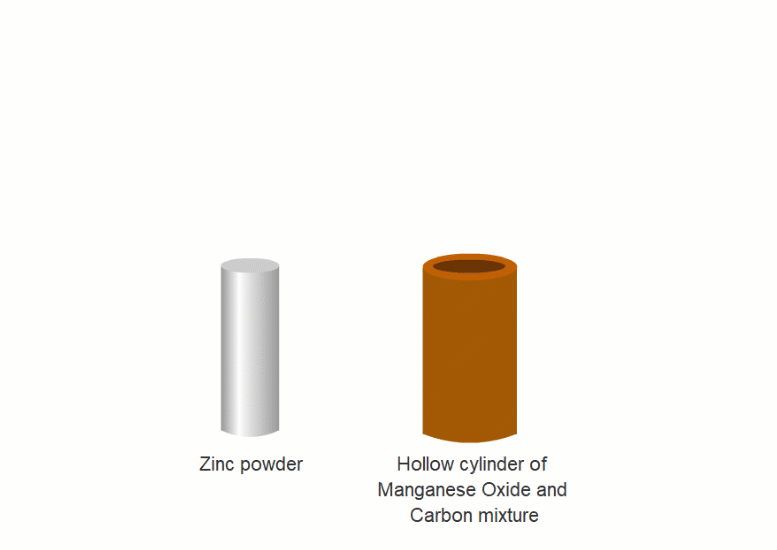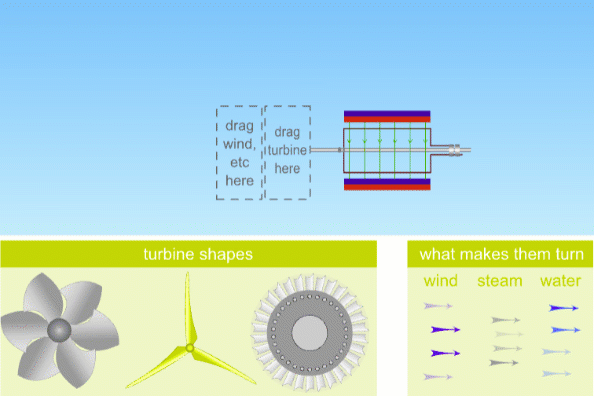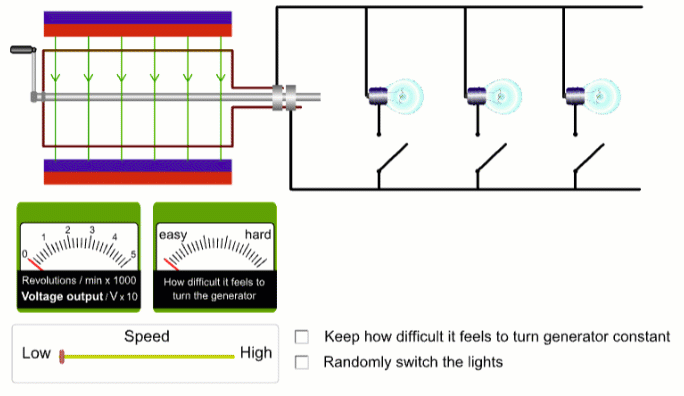Battery and generator voltage and the invisible 4th Law of electric circuits
When we have a simple circuit and we change the resistance, we can use the I=V/R relationship to calculate the new current.
That’s true, but there is a crucial assumption there that is almost never mentioned which is this:
Power supplies are designed to be constant voltage providers
If you don’t know this, then on what basis can you keep V constant? What you’re really asking is something like ‘How does this power supply respond to a change in resistance?’ And the answer is ‘By keeping its voltage constant, and changing the current it provides.’
The circuit simulation shows that as you change the resistance of the bulb (in reality you’d have to swap bulbs) the battery voltage stays constant, but the current supplied by the battery changes.
Let’s just put in a couple of caveats. The first is that there are power supplies that are designed to provide a constant current, rather than a constant voltage, but these tend to be quite complex in their design and are not how batteries or the mains behave, which is what we study at this level. The second is that power supplies are only designed to provide a constant voltage for some given range of currents. If you try to make them provide a bigger current than they’re designed for (that is, if you try and make them work too hard) then the voltage they supply will drop. This is why you can’t start you car by connecting nine 1.5 V AAA batteries end to end instead of a 12 V heavy duty battery.
The three laws we normally use are not enough to fix the value of current or p.d. in an electric circuit if we change the resistance
We use three laws to analyse electric circuits. In no particular order…
Conservation of charge - Kirchoff’s 1st Law - this says that the current into any point must be the same as the current out, so the current is the same at any point in a simple circuit
Conservation of energy - Kirchoff’s 2nd Law - this effectively says that the voltage drops to zero if you take a loop from one side of a battery to the other, so the p.d. across the load is equal to the battery voltage
The R=V/I relationship - this says that there is a property of a component called its resistance that tells you what current will flow through it if you know the p.d. across it. If the resistance doesn’t change with current, we say the component obeys Ohm’s Law.
But what happens if we change the resistance? It turns out that there are an infinite number of values that the current and voltage can take and still be consistent with all three laws.
For example if R = 12 ohms then we can have any of these pairs
V= 24 V, I = 2 A
V = 12 V, I = 1 A
V = 6 V, I = 0.5 A
plus an infinite set of other pairs which give 12 when the voltage is divided by the current.
This infinite set of solutions is essentially what’s predicted if you believe that voltage and frictional force are exactly analagous in the rope loop model.
We can only get out of this infinite set of solutions problem if we know that the power supply is designed to keep the voltage it provides constant. As soon as we do that, then we fix V and we can only get one value for I.
Batteries and the mains are rated in volts, not amperes or watts
The idea with a battery is that you can make one without having any knowledge about what it’s going to run. You can use the same battery to run a torch, a TV remote or a hand fan.
All the designer of the electrical device needs to know is the voltage the battery provides. The battery will supply whatever current is demanded of it, as long it’s not too big. If the current gets too big then the battery gets less and less efficient and starts heating up, rather than running the device. This has the effect of reducing the apparent battery voltage, so the device either runs slower or won’t work at all.
Similarly with the mains. All the designer of an appliance, like an electric oven or a vacuum cleaner needs to know is that the mains provides a predictable voltage. The mains can provide an arbitrarily large current, as long as it’s not so big that it trips out the main house circuit breaker.
That’s why batteries and the mains are not rated in amperes or watts - they’re rated in volts, and they’re designed to maintain that voltage within a specified range of currents.
The alternating mains voltage doesn’t change, but the current supplied depends on what’s connected. The more things that are connected, the bigger the current.
The fixed voltage, variable current output is partly nature and partly engineering
Batteries use fixed chemical reactions that change their rate to deliver different currents
Batteries keep their voltage constant because the chemical reactions that make batteries work liberate a fixed and predictable amount of energy per electron (that is released at one electrode, while another electron is absorbed at the other).
A battery changes the current it delivers by changing the rate at which the chemical reactions happen - fast reactions mean a big current, and energy is shifted quickly.
Different chemical reactions liberate different amounts of energy per electron. So the voltage is determined by what chemicals the battery uses.
An alkaline AA battery that you can buy in any shop has an output of 1.43 V because it uses zinc and manganese oxide electrodes in a potassium hydroxide electrolyte. Strictly, this basic unit is called a ‘cell’. You can join cells together in series to create a higher voltage ‘battery’. (The name comes from the similarity with a gun battery, which is a series of e.g. canons used together).
You can create a 9 V battery by connecting six zinc-manganese cells in series, and packaging them so they look like a single item. The actual output is about 8.6 V.
The lead-acid battery that starts your car uses six 2.05 V lead-acid cells to give an output of 12.3 V. Each cell uses one lead and one lead oxide electrode in an electrolyte of dilute sulfuric acid.
A highly simplified visualisation of the chemical reactions in a battery. In reality positive and negative ions flow in the electrolyte, not electrons.
Generators use fixed rotation speeds - the bigger the current demanded, the harder they are to spin at that speed
Most electricity is generated by spinning powerful electromagnets - some as big as an SUV and weighing up to 100 tonnes - inside a cylinder surrounded by coils of wire. A voltage is produced (‘induced’) in the coils of wire, and it is the ends of these wires that are ultimately the source of the live and neutral wires that are connected to your toaster and mobile phone charger.
The electromagnets are spun by a turbine which sits just in front of the generator. A turbine is like a windmill that spins when a liquid or gas flows past it. Turbines can be spun because of high pressure, high temperature gases like steam, or moving water, or just the wind.
The turbine and the electromagnets are on the same shaft and spin at the same rate.
A gas turbine spins by burning methane at very high pressure and directing the exhaust gases screaming through the turbine blades to make them spin - it has a similar design to a jet engine, except all the exhaust gases go through the turbine, rather than being ejected at the back in a high-speed stream.
In a nuclear power plant reactor, nuclear reactions in the fingertip-sized uranium oxide fuel pellets make the metal rods that contain them very hot. Water is forced past the metal rods and they act a bit like the heating element in your kettle - boiling the water into super-heated high-pressure steam.
This steam is used to heat pipes that boil uncontaminated water into a different loop of super-heated high-pressue steam and it’s this steam that is blasted through the turbine.
Biomass power plants like Drax burn macaroni-sized compressed wood pellets to create the steam.
With hydroelectric generation, water from a reservoir falls through a turbine, which spins the magnets in the generator.
In this simplified animation we spin the coils of wire not the magnets - the effect is the same. Different turbine shapes are used for water, wind and steam.
Whether the gas racing through the turbine is steam or exhaust gases, the temperatures, pressures and speeds are much higher than anything we’re used to. Temperatures of up to 1000 C, pressures of 45 atmospheres and gas speeds of 1000 km/h are common. Nuclear reactors can boil a tonne of water per second completely away into high-pressure steam.
The voltage a generator produces depends on the design of the magnets and coils, and how fast the magnets are spun by the turbine.
With gas and steam turbines, the rotation speed of the turbine is carefully regulated to keep the magnets spinning at exactly some multiple of 50 revolutions per second (because 50 Hz is the frequency of all mains power), and is designed so that that rotation speed will produce a fixed voltage (normally ~10,000 V) that can be transformed up and down by the existing power network to arrive at your home as the 230 V mains.
If the rotation speed drops then the voltage drops, so you need to increase the gas pressure to speed up the turbine and hence the electromagnets.
If the rotation speed is too high then the voltage increases, and you have to pipe some of the gas so it goes straight to the back of the turbine, rather than through it - the gas pressure drops and the rotation rate decreases.
If the generator is not running any appliances - like ovens, lighting, hair dryers, industrial fryers, etc - then it’s comparatively easy to keep the turbine and the magnets spinning. It’s like freewheeling a very heavy bicycle down a gentle slope. The voltage is still there, ready to be accessed, but there’s no current flowing. This is like having a battery in your drawer, or in your torch, but not turned on.
But once thousands of people start using their washing machines and electric mowers and tumble dryers, then all of that effort has to come from somewhere, and it comes from making the magnets much more difficult to spin at the right speed. To keep them spinning you need to create turbine gas faster to blast through the turbine, and that means burning gas or wood pellets faster (fairly easy to do) or changing the rate of nuclear reactions (not hard in principle, but tends not to be done).
This is why wasting electricity by e.g. leaving lights on means more gas is burned and more carbon dioxide is released into the atmosphere.
The forces are huge. In a big generator in a power station running at full power, the gas is screaming through the turbine blades at about 1000 km/h and creates a turning effect equivalent to suspending a family car on a lever 1 km long.
The magnets get more difficult to turn because as the current in the coils increases - to supply all those houses, factories, offices and shops - the coils themselves turn into electromagnets, and these electromagnetic always have their poles oriented in such a way that they try and slow down the spinning electromagnets.
In this simple DC hand-cranked generator, you can see how spinning it faster causes a bigger voltage, and that as you make it run more lights (and so increasing the current it provides) the generator gets harder to spin at that speed.
So batteries keep their voltage constant because of natural chemistry, and power plant generators keep their voltage constant by clever engineering and continuous regulation.
Gas power plants typically take the hot exhaust gases that come out of the back of the turbine and use those to boil water into steam that then spins a steam turbine, running another generator. This is called a combined cycle gas turbine (CCGT) - because it combines a gas turbine (running off hot exhaust gases) with a steam turbine (running off steam boiled from water heated by the waste exhaust gas from the back of the gas turbine). CCGTs are about 60% efficient at creating electricity from gas.
In the UK about 40% of electricity is generated by burning gas, 15% by nuclear and 5% by biomass. All these use turbines run by super-fast high-pressure hot gases (whether exhaust gases or steam), to spin the magnets in a generator.
Wind turbines generate about 30% of UK electricity. These also work by spinning magnets near coils of wire, but with wind turbines the rotation of the blades spins the magnets directly. Modern large wind turbines use a big ring of permanent magnets each about the size of a phone which spin (comparatively) slowly at the same speed as the turbine rotates. The permanent magnets are so strong that they could pick up a car!
Because the wind changes speed and direction all the time, each turbine in a farm will produce a range of voltages and a.c. patterns. To feed into the grid - which requires very specific voltage ranges, a.c. frequencies and phases (how in step one a.c. pattern is with another) - the a.c. voltage output is turned into d.c. (using devices called a rectifiers) and then into a.c. of the right voltage, frequency and phase (using devices called inverters).
Just like with generators run by gas turbines, the more current the grid draws from a wind turbine, the harder it is to turn the blades at the same speed. Modern turbines continually adjust the angle that the blades make with the wind to try and keep the speed fairly constant.





